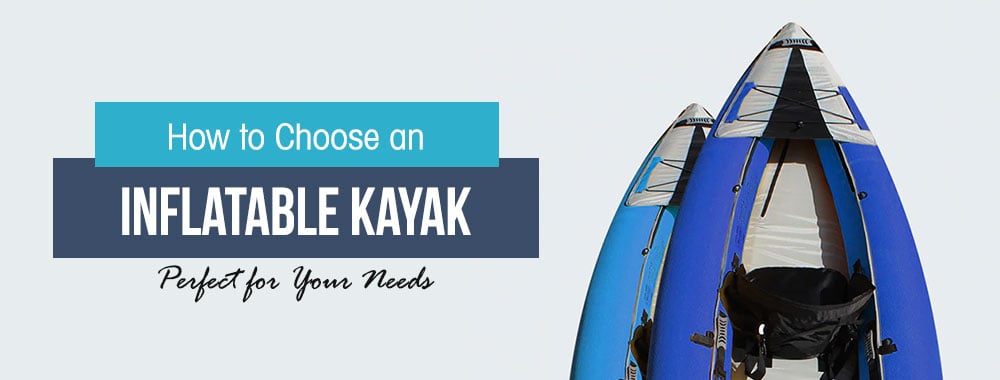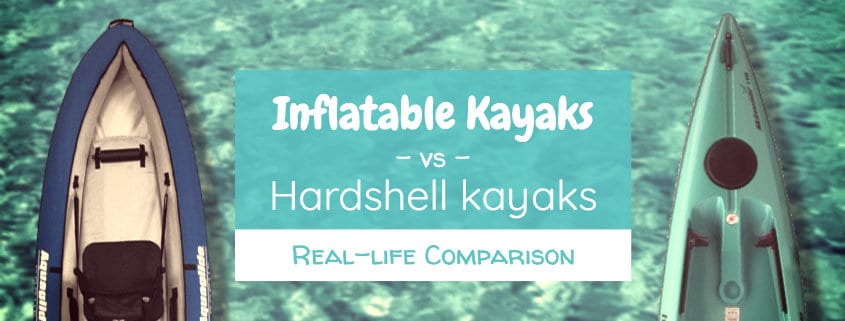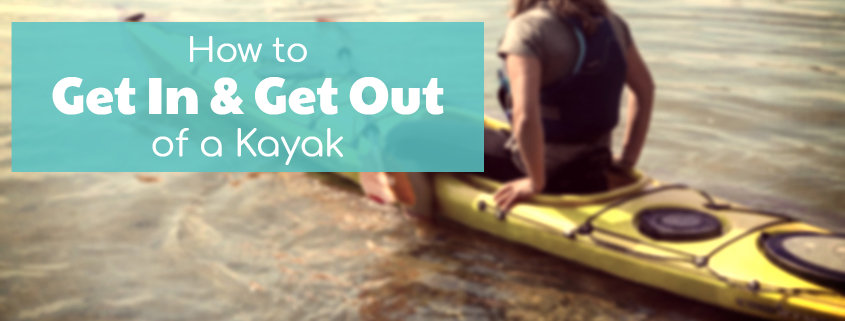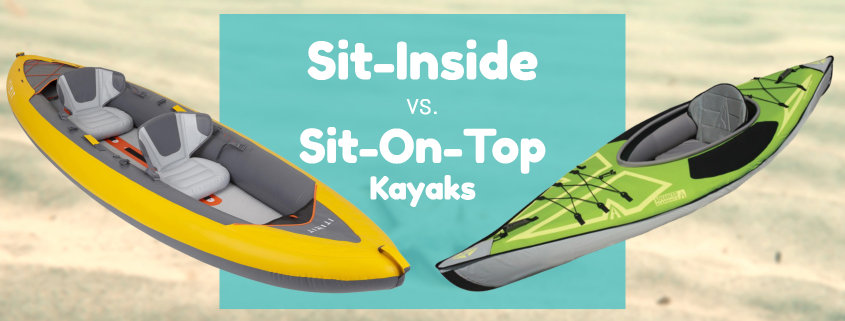Inflatable kayaks are a popular choice for many paddlers because of their portability and versatility.
Whether you’re looking for a kayak for fishing, touring, or whitewater paddling, there’s an inflatable kayak out there that will suit your needs.
But with so many different models on the market, how do you know which one is right for you?
In this article, we’ll give you some tips on how to choose an inflatable kayak that is just right for your needs.
Before I go into details on what features you should look for, watch this insightful video on the subject.
Contents
Usage-based requirements
Kayaks are manufactured differently and incorporate different features based on how they will be used and in what bodies of water. Some of them are purpose-built for use under extreme circumstances.
While no single kayak can perform well in all conditions, you should get one that will do well for most of what you intend to use it for.
Based on this, we can differentiate the following inflatable kayak categories:
Recreational
The most basic type of kayak is the recreational kayak. They come in sit-on-top and sit-inside versions and are an affordable way to get on the water.
They are suitable for recreational activities, like paddling on calm water, lakes, and even slow rivers.
Day touring
Day touring kayaks carry a higher price tag than recreational models, but are of higher quality in general. They come in sit-inside and sit-on-top variations as well.
Day tourers are sleeker, are easier to control, and also offer some cargo space for your gear.
Touring
Touring kayaks are much longer than day tourers, which increases their speed and optimizes their tracking capabilities.
You can go on extended journeys in touring ‘yaks, as they are more comfortable and offer more storage space.
If you are not 100% intent on going on long trips though, you will be better off with a day tourer.
Whitewater
The body of whitewater kayaks is shaped in a way that helps you navigate through raging rapids, and their material is super durable to resist tears and punctures. They also have scupper holes to allow water collected in the cockpit to drain away.
They do not have a skeg (or it is removable), as it would be an obstruction.
Fishing
An inflatable fishing kayak offers extra features that anglers need, like fishing rod holders, mounting pads, and mounting brackets. Here is a list of awesome inflatable boats & kayaks made specifically for fishing.
So in review:
Flat water (lakes, ideal weather) = Recreational kayak
Multi-day trips = Touring kayak with room for camping gear
Slow-moving rivers = Touring or day-touring kayak
Whitewater rapids = Whitewater kayak
Sea/ocean = Touring or sea kayak
Winter = Rugged kayak with sealable cockpit
Fishing = Fishing kayak
Types of Inflatable Kayaks
Before we get into the nitty-gritty details of how to choose an inflatable kayak, you should know that there are 2 main types of kayaks:
Sit-on-top kayaks (SOT)
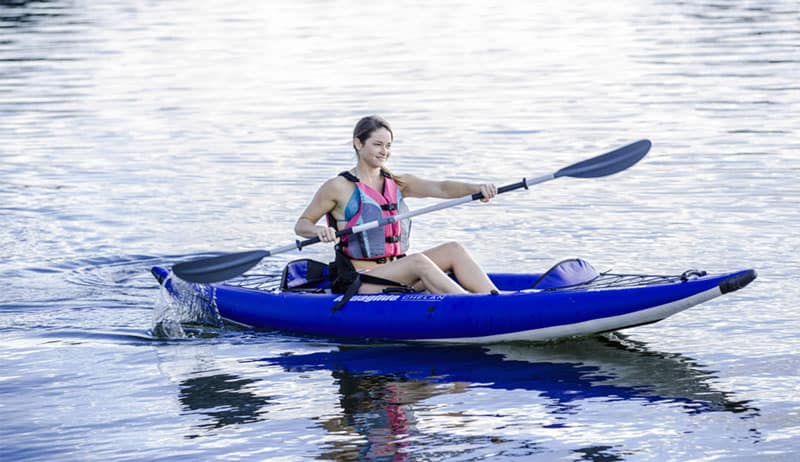
SIKs have a closed cockpit, where your position is on the water level or even slightly below it.
Sit-inside kayaks (SIK)
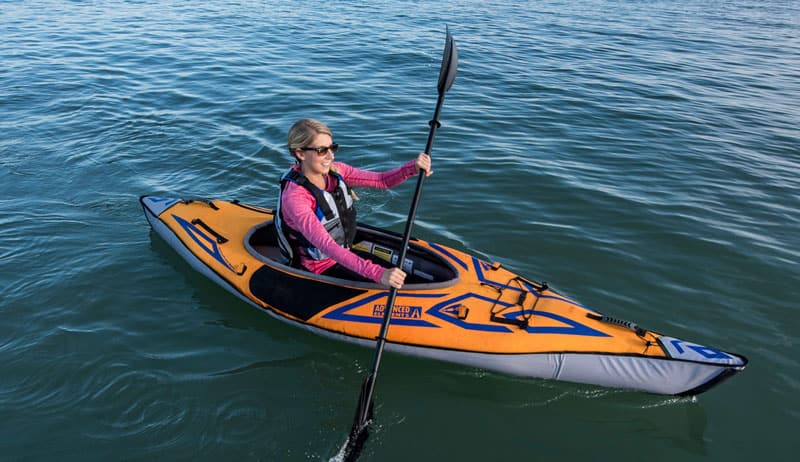
With SOTs, you sit on the deck, so your position is above the water level.
In general, SOTs are a better option for beginners, and SIKs are suitable for intermediate and advanced paddlers.
There is a lot to be said about the advantages and disadvantages of each, which is why I recommend you read my article on sit-inside vs. sit-on-top kayaks.
Your budget
Inflatable kayaks cost between $90 to $2,000.
Quality, comfort, and features are in-line with how much you pay, there aren’t any surprises in this respect.
I have a detailed article on how much inflatable kayaks cost with examples here.
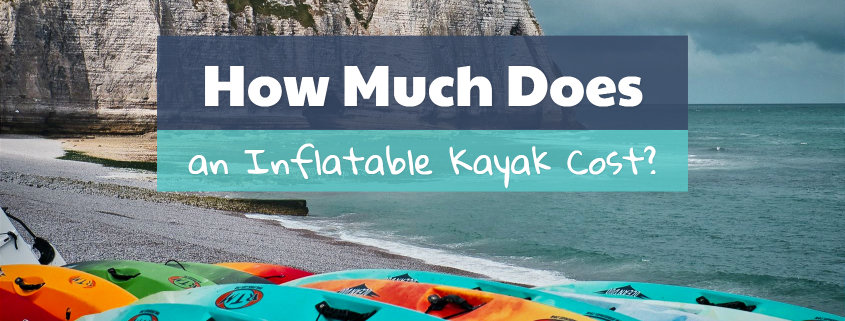
Body and cockpit size
One of the most important aspects of choosing the right inflatable kayak for your specific requirements will be its body size and capacity.
For a short person, the size of the cockpit will not matter that much. However, if you’re tall and the cockpit size is small, you will be cramped and uncomfortable.
While adjustable seats can help, not even they will help if the cockpit is too small.
My recommendation is that if you’re under 183 cm (6′), paddle solo most of the time, and don’t have much gear, you can go with a 1-person inflatable kayak.
However, if you’re tall or need more storage space, it is a good idea to go with a 2-person (tandem) model. That will also ensure that you get more storage space and room for your legs in the cockpit.
It can save you a lot of discomfort in the long run and will provide you with plenty of space in the cockpit for storing all the gear you take on the occasional overnight camping trip.
Controlling a 2 person inflatable kayak when paddling solo is not more difficult as long as you reposition the seat to the center. Doing so will provide you with excellent control, and you won’t look like a paddler doing a kayak wheelie.
Storage space
The amount of storage space the boat offers is essential if you plan on carrying gear along.
You can store gear in many ways on a kayak if it has the following features:
- Cargo nets on the deck,
- Storage compartments in the cockpit,
- Hatches,
- Hooks and loops you can tie things to.
You have to decide which storage methods you prefer and choose a suitable kayak to fit all your gear.
Weight capacity
Inflatable kayaks in general have a larger maximum weight capacity than hardshells, since they are so buoyant thanks to the air bladders.
Nevertheless, you will want to check this specification as well, just to make sure.
Remember to add the weight of all passengers and gear for your calculation.
Features you need
Kayak manufacturers have added loads of extra features to their boats lately. But do you need them all?
I categorize them as:
- Need to have features
- Nice to have features
- Don’t need the feature
Here is a list and explanation of the extras you’ll come across when reviewing kayaks on the market. It’s a good idea to make a checklist of the ones you think you’ll need on your paddling adventures, and look for them on your kayak shortlist.
Ergonomic carrying handles
All kayaks need carrying handles to move them around, but not all handles are created equal. You have to not only look at the handles’ design, but also the padding of the handles, and their positioning.
The kayak should have ergonomic handles on both ends and should be easy to carry.
Do you need ergonomic carry handles on your kayak? Yes, they are definitely a need to have feature of inflatable kayaks.
Seat design
Ideally, it is best to choose an inflatable kayak with adjustable seats, which allow you to move the backrest into a comfortable position. Good back support will mean you will not suffer from back pain after a long trip (also known as “yak back”).
You can also set the elevation of some seats to make sure you never have to sit in water splashed into the cockpit, but this is a rare feature.
Seat padding is usually not an issue, but you should still ensure the seat is properly formed and padded for many hours of pain-free paddling.
However, if you get a kayak with a dropstitched high-pressure floor, make sure it comes with a properly padded seat. Dropstitched floors are very hard, and sitting on one for hours without ample seat padding is painful.
The seat design, its adjustments, and padding will determine the comfort which it provides.
Do you need a kayak with good seat design? You will be sitting 100% of the time when paddling, so it’s important to have comfortable seats. However, you can get aftermarket kayak seats, or even just add padding yourself.
Effective splash guards
If you’re looking at sit-on-top kayaks, it is good to choose one with front and rear splash guards to reduce the amount of water that gets into the cockpit.
These can ensure that the gear in the storage compartment and the storage space remains dry. Or at least mostly dry.
If you want to stay completely dry though, you will need a sit-inside kayak with a coaming and spray skirt.
Do you need splash guards on your kayak? If you plan on going on turbulent waters, it is a good idea to have splash guards to keep the waves and splash from entering the kayak.
Spray skirt
A spray skirt (aka. spray deck) is a flexible, waterproof skirt you pull onto your waist and attach to the coaming around the cockpit opening of sit-inside kayaks.
This is useful under certain circumstances:
- During winter paddling in cold temperatures, a spray skirt will keep the inside of the yak relatively warm.
- A spray skirt can keep you 100% dry during whitewater kayaking when you would otherwise fill up with water. It also enables Eskimo roles.
Do you need a spray skirt? If you go whitewater or winter kayaking, having a spray skirt is a good idea, but not a must-have.
Sturdy carry bag
Whether you like it or not, your kayak will probably be deflated and stored most of the time.
That is why you should choose one which comes with a proper duffel bag, as it is the most secure way to store the kayak and will also ensure that takes up the least amount of space possible.
The carry bag should be of excellent quality, so it does not tear. It will have handles, of course, but having backpack-style straps is a big plus when you need to carry it on longer distances.
Do you need a carry bag? The reason you are getting an inflatable kayak is for the easy portability, so having a carry bag that makes this possible is important.
Accessories
Some kayak packages come with loads of accessories, but some have very few.
The 2 most important accessories you should know about are:
- paddles (here is a detailed article on how to choose kayak paddles)
- air pump (here list of the manual and electric air pumps I use)
If the kayak you are looking to get does not include these, you are looking at spending another $100-150 for a decent paddle and a hand pump (or foot pump).
You generally don’t need an electric pump for inflatable ‘yaks, since they are easier to inflate than bigger inflatable boats and SUPs.
Do you need to get accessories? Yes, you will need a pump and a good kayak paddle if your package does not include one.
Comfortable footrests
Footrests keep your feet and legs supported, which is vital for proper paddling form. They also help keep your legs in a comfortable position.
Top-tier inflatable kayaks have footrests, but most of them do not. This will mean that you need to place your feet in between the hull and side tubes. It works but is not ideal.
Do you need footrests in your inflatable ‘yak? Footrests make kayaking more comfortable on long trips, but they are not a must-have.
Skeg
A skeg is nothing but a plastic fin that is attached to the bottom of the kayak. While it might seem like a small feature, it can help you immensely out on the water.
I have an entire article about inflatable boat skegs here.
In short, skegs help you control the vessel and increase paddling efficiency. You can tackle crosscurrents as well as crosswinds more effectively with a skeg.
Do you need a skeg on your inflatable kayak? You absolutely need to have at least one skeg on an inflatable kayak, but make sure it is removable if you plan on going on whitewater.
Drain plugs
Drain plugs (scupper holes) allow the boat to drain away any water which enters the cockpit. You can open and close the plugs as you need.
Scupper holes are most significant for whitewater kayaking, where water splashes onto the deck. They also make it easier to correct a flipped kayak.
Do you need drain plugs on your kayak? If you plan on going on white water or in ocean waves, you need to have drain plugs. Otherwise, you don’t.
Setting up and packing away
Inflating a kayak is very easy, even without an electric pump. There 3 chambers you need to inflate in a specific order and should take no longer than 10 minutes.
Here is a detailed article on how to inflate kayaks.
Deflation is a bit trickier, but interestingly, nobody asks about it.
You should pay attention to 2 things:
- The air valve should allow a lot of air out quickly. Look for boats with “check valves” like the Boston valve or the Halkey-Roberts valve. They make inflation easy as they do not let the air out, but at the same time, a simple twist will open them up to quickly deflate the boat.
- Kayaks that have fabric covering the air bladder are harder to dry. You never want to put a damp boat into storage, as it will develop mold. If you don’t have time to dry it right after use, you need to open it up and let it dry completely at home.
Once your ‘yak is completely dry, you simply fold it up and put it into its carry bag where it will await your next adventure.
Repair kits
Most inflatable kayaks come with a repair kit in case they are punctured: a patch kit, glue, and other tools needed for the repair.
You can repair small punctures or tears on the spot, but that is unlikely to happen.
An inflatable kayak will easily last for 10+ years if you look after it well. How you need to take care of it depends on the material it is made of, as well as how & where you use it.
Do you need a repair kit for your kayak? If your puncture your kayak, it is good to have a repair kit, but you can always buy on.
Summary
If you’re still reading this, the type of kayak right for you should already be forming in your head.
Let’s summarize what you’ve learned on how to choose an inflatable kayak.
- Consider the type of water you’ll be paddling in most often—calm lakes or rivers, or rougher waters like the ocean or whitewater streams.
- Also, think about how you’ll be using your kayak—for recreation, fishing, camping, or touring.
- If you plan to do a lot of fishing from your kayak, make sure it has enough storage space and features for gear and fish.
- Kayaks designed for whitewater are shorter and narrower than those meant for calm waters, making them more maneuverable but less stable.
- Choose a kayak that fits your body size and weight—a too-small kayak will be uncomfortable and harder to paddle; a too-large one will be unwieldy.
- And finally, compare prices from different retailers before making your purchase.
With these factors in mind, you can choose the perfect inflatable kayak for your needs.

